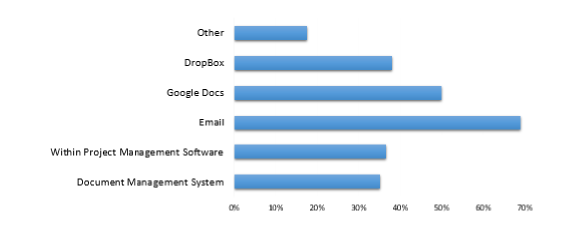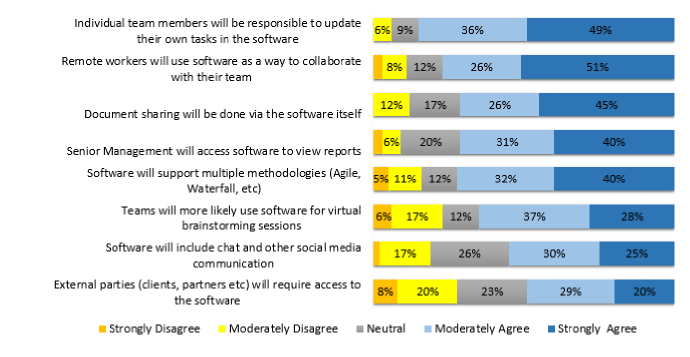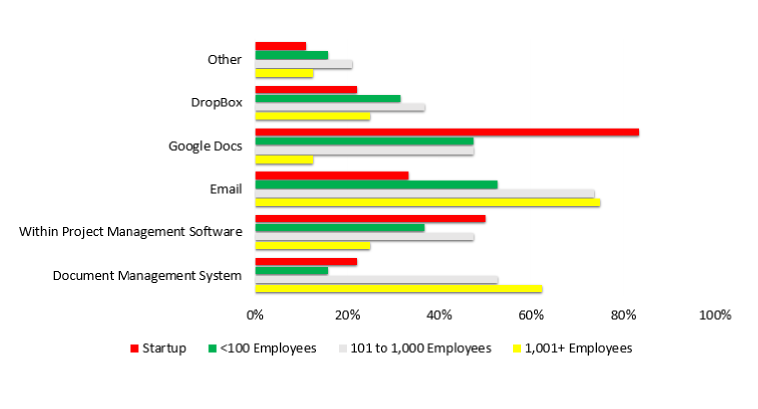Introduction
In recent years, there has been a proliferation in the number of Project Management Software solutions in the marketplace. The increase in popularity of Project Management Software can be traced to structural changes in the workplace and the demand for real-time collaboration. Today’s project teams are comprised of remote and offshore workers that are often in different time-zones. Software has evolved from Project Manager driven (Gantt Chart) to team led (collaboration and integrated task management).
The purpose of this study is to look at the future trends in Project Manager software by understanding the underlying drivers of user behavior. Teams and organizations are adapting to a changing work environment.
In addition to surveying users from large organizations, we have researched users in medium and small businesses as well as startups. Each segment has unique needs and project management software buyers can benefit from the insights of their respective peers.
Our goal is to provide a benchmark of user requirements to prospective buyers of project management software. The insights from this study can help forward-looking team leaders prioritize their requirements and plan for future growth.
Summary of findings
Project management software is team-driven. Only 14% of respondents view the project manager as responsible for accessing the tool and three-quarters of users state that individual team members update their own tasks. There was almost a consensus from all respondents from all company sizes that all team members need access to project management software.
Of the respondents who do not access project management software, the most common reason (38%) is because it is perceived as too complicated.
Today’s project teams expect to collaborate on and share documents within the project management software. Team members increasingly use Google Docs (52%) and Dropbox (38%) to share documents driving a requirement for integration of these features in project management software. In the future, the use of document sharing via the project management tool will become even more prevalent.
In the future, team members will be even more responsible for owning and updating their tasks (85% of respondents Strongly Agree or Somewhat Agree). Another trend is that remote team members expect to use project management software to collaborate with their team members (77% of respondents Strongly Agree or Somewhat Agree).
Project management software is of value to the business. 59% of respondents believe that project management software helps team members achieve business objectives. 50% stated that it helps make sure that project deadlines are met.
Based on this research, a number of conclusions can be made:
- The definition of project management software is expanding to include team related functionalities that support projects in varied ways. Our forward-looking research indicates that the definition will continue to broaden.
- There is a shift away from traditional role of the project manager as more functions are being done collaboratively. Potentially this can free up the project manager to take on productive task or to be reassigned to a more strategic role.
- Structural changes in the corporate work environment such as the expectation that teams will work via remote has changed the requirements for project management software.
- Within startups and on small teams, there is less of a perceived need for a dedicated project manager. Small teams often view project management as a cost center and are more inclined to try software solutions that can replace the project management functionalities.
- There are significant differences in opinion based on the size and maturity of an organization. For instance, startups tend to be much more concerned about the complexity of a project management software than larger organizations. At the same time, startups are more likely to believe that project management software should be used for document sharing.

The current state: how project management software is used
It is clear from our research that transparent workflows have become standard requirements. Three quarters of respondents indicated that individuals are responsible for updating their tasks in the software. A mere 14% believe that it is the responsibility of the project manager to own and manage the project plan.
chart 1: How Teams Use Project Management Software

52% of respondents indicated that project management software is used for document collaboration and sharing which is a higher number than we expected. Given the ubiquity of social media, it is unsurprising that 27% of respondents use online chat to communicate with team members. Almost 20% of respondents use project management software to brainstorm with team members.
Chart 2: Experience with Project Management Software

The above graph contains some surprising data:
- 30% stated that management access project management software for reporting.
- 59% of users indicated that project management software helped the team achieve their project deadlines, although on 50% stated that the software helped achieve business goals.
- A relatively high 36% of respondents stated that the software was used primarily by the project manager to create a project plan.
Chart 3: Who Accesses Project Management Software?

It appears that even when project teams use project management software, the level of access varies. Whereas 57% of respondents claim full access to the software, 31% indicated that the project manager is the gatekeeper, but the team has limited access. Only 9% of respondents stated that the project management software is limited to the project manager alone.
Perceptions of software complexity
A common characterization of project management software is that it is too complex to use. Perhaps as a legacy of Microsoft Project that was only accessed by the project manager, complexity is still a barrier to project management software adoption.
chart 4: reasons why project management software is not accessed

We wanted to find out why some team members do not access project management software. The most common reason for not accessing software (38% of respondents) was due to the fact that the software is perceived as too complicated to use. A further 31% of users stated that there is no need to use the software though they have permissions. Only 25% of respondents would like to use the software but are prevented from doing so because they do not have permissions.
chart 5: concern about software complexity (Based on segment)

When it comes to the issue of software complexity, there is a correlation between the company size and/or maturity and the perceived complexity of project management software. Generally, employees of startups consider project management software as too complex (34% of startup respondents Strongly or Somewhat Agreed) whereas employees of larger companies have less concern about this issue. Survey respondents from companies with over 1,000 employees Strongly Disagreed (19%) or Somewhat Disagreed (56%) with the notion that software is too complex.
Feedback on current software capabilities
Respondents were asked about 7 use cases of project management software and to rate them on a five-point scale. The highest ranking feature was the ability for team members to update their own project status (4.6/5.0) and the lowest ranking feature was the ability to collaborate via chat (2.7/5.0).
chart 6: Ability of team members to update project status

94% of respondents indicated that it is Very Important or Somewhat Important for team members to update their project status. 6% were neutral and there were no respondents who indicated that it was not important.
chart 7: Ability to view all tasks in one dashboard

90% of respondents indicated that it is Very Important or Somewhat Important for team members to view all tasks in one dashboard. 8% were neutral and only 2% indicated that it was Somewhat Important.
chart 8: Ability to share project documents between team members

The ability to share documents between team members is very important to project management software users. A further 41% of respondents stated that it was Very Important. A further 30% indicated that it was Somewhat Important. A mere 11% of respondents indicated that it is Somewhat Unimportant or Unimportant.
chart 9: Ability to access project plan Gantt Chart

63% of respondents indicated that it is Very Important or Somewhat Important for team members to access the project plan Gantt Chart. 19% were neutral which is almost one in five. A significant number of respondents (18%) stated that it was Somewhat Unimportant or Unimportant for team members to access the Gantt Chart.
Chart 10: Ability to track time spent on a task

56% of respondents indicated that it is Very Important or Somewhat Important for team members to track time spent on a task. 22% were neutral. A significant number of respondents (22%) stated that it was Somewhat Unimportant or Unimportant for team members to track time spent on a task.
Chart 11: Ability to run virtual whiteboard sessions

39% of users were neutral about the importance of running virtual whiteboard sessions. A further 37% of respondents stated that it was Somewhat Unimportant or Unimportant for team members to run virtual whiteboard sessions. Only 22% of respondents indicated that it is Very Important or Somewhat Important for team members run whiteboard sessions.
Chart 12: Ability to collaborate via chat

The largest response (30%) was from users who were neutral. A significant number of respondents (43%) stated that it was Somewhat Unimportant or Unimportant for team members to collaborate via chat. Only 27% of respondents indicated that it is Very Important or Somewhat Important for team members to collaborate via chat.
Although the majority of respondents were neutral or did not consider chat to be an important feature of project management software, the 27% of respondents who indicated otherwise still represent a significant percentage of users.

Prioritization of software functionalities
We asked survey respondents to provide feedback on which product functionality is important in standard project management software packages. Specifically, we received survey responses on questions relating to team access to project management software, document and file via the software and team-related collaboration.
Team access to project management software
As transparent workflows become standard, project teams expect to have complete access to the project management software. This is attributable to the changing role of the project manager and the evolving functionality of project management tools.
Should teams members have access to project management software?
Users were asked to whether they agreed with the statement that project teams should have access to the project management software. Below is a breakdown of response data broken down by organization type (Startup, small business, medium business and enterprise).
As the charts below indicate, there is across-the-board support for the notion that team member should have access to project management software. Although there was moderate resistance to this within the small business segment, on the whole most respondents expect team access.
In fact, team access for project management software is the most agreed upon requirement.
chart 13 a: Startup segment response group

chart 13 b: Small Business (<100 Employees)

chart 13 c: Medium Business (100 to 1000 Employees)

chart 13 d: Enterprise Business (1001+ Employees)

DOCUMENT COLLABORATION
In recent years, more project management software solutions have included document collaboration features. We asked users to identify how they share documents and to what extent document collaboration is a priority.
chart 14: How are documents shared between team members?

It is not surprising that email is the primary way for sharing documents (69% of respondents). What was also interesting is the popularity of Google Docs (50%) and DropBox (38%). The widespread use of Google Docs is interesting given that Microsoft has just released it Microsoft Planner tool which will not integrate with Google Docs.
Another finding of note, is that more respondents share files within their project management software (36%) than via a document management system (35%).

Should project management software be used for document sharing?
Users were asked to whether they agreed with the statement that project management software should be using for document sharing. Below is a breakdown of response data broken down by organization type (Startup, small business, medium business and enterprise).
chart 15 a: Startup segment

Only 6% of respondents Somewhat Disagree that project management software should be used for document sharing. 39% Strongly Agree and 33% Somewhat Agree.
chart 15 b: Small Business (<100 Employees)

Within the Small Business segment of fewer than 100 employees, 50% of respondents Somewhat Agree or Strongly Agree that document sharing should be part of project management software. The biggest response was “Neutral” which was indicated by 40% of respondents.
chart 15 c: Medium Business (100 to 1000 Employees)

On the whole, there was widespread support from respondents in the Medium Business segment for document sharing to be part of the project management software. 37% of respondents were neutral. The remaining respondents Strongly Agree or Somewhat Agree.
chart 15 d: Enterprise Business (1001+ Employees)

In the Enterprise space, 50% Somewhat Agree or Strongly Agree that document sharing should be part of project management software. However, 32% Somewhat Disagree or Strongly Disagree with this statement. Our assessment is that larger companies are less likely to use Microsoft SharePoint or other Enterprise-grade document management solutions and do not see project management software as the mechanism for sharing documents.

TEAM RELATED COLLABORATION
Should project management software be used for team collaboration?
Users were asked to whether they agreed with the statement that project management software should be used for team collaboration. Below is a breakdown of response data broken down by organization type (Startup, small business, medium business and enterprise).
Positive attitudes towards team collaboration are strongest in the startup segment. 56% of respondents Strongly Agreed and 22% Somewhat Agreed that project management software should be used for team collaboration. Only 12% disagreed with this statement. In the Enterprise segment, although 38% Strongly Agreed and 13% Moderately Agreed with the statement, 19% Somewhat Disagreed and 31% were Neutral.
What does this tell us? Employees at startups tend to view project management software as a platform for team collaboration whereas many employees at larger and more established companies do not share the same view.
chart 16 a: Startup segment

chart 16 b: Small Business (<100 Employees)

chart 16 c: Medium Business (100 to 1000 Employees)

chart 16 d: Enterprise Business (1001+ Employees)

Project management requirements for the future
Respondents were asked to evaluate the following eight statements about the future of project management software. The list below contains the eight statements listed in order of popularity:
- Individual team members will be responsible to update their own tasks in the software
- Remote workers will use software as a way to collaborate with their team
- Document sharing will be done via the software itself
- Senior Management will access software to view reports
- Software will support multiple methodologies (Agile, Waterfall, etc.)
- Teams will more likely use software for virtual brainstorming sessions
- Software will include chat and other social media communication
- External parties (clients, partners etc.) will require access to the software
In the chart below, we show a breakdown of users’ responses to each statement:
chart 17: feedback on future trends in project management software

The most striking and consistent finding from this research is the importance of individual team members assuming responsibility for updating their own tasks in the project management software. 49% of respondents Strongly Agree with this statement and 36% Moderately Agree. Our conclusion is that this high number represent a shift in how project teams are managed.
The top-down project management role has changed and individuals team members are expected to take on more responsibility. At the same time, project managers no longer own the project plan and are not expected to follow up on each task status. More than half (51%) of respondents Strongly Agree that remote teams will use project management software for collaboration. A further 31% of respondents Moderately Agree.
This finding suggests that the global move to increased outsourcing and telecommuting has created a need for better collaboration between team members. It is noteworthy that remote workers view project management software as the mechanism for collaboration and where there are other available options such as social media (e.g., Facebook Messenger and Google Hangouts) or other communication tools such as Skype.
We were surprised by the relatively high ranking of Document Sharing as part of the project management software itself. 71% of survey respondents indicated that they Strongly Agree or Moderately Agree with this statement. In the Enterprise space, Microsoft SharePoint and other Document Management solutions have gained popularity over the last few years, but these are not integrated into project management software. For instance, Microsoft Project and Microsoft SharePoint are not compatible which has been the cause of much frustration on the past of project teams.
Another trend we have seen in this research is the strength of both Dropbox and Google Docs. In particular, startups are using Google Docs. In parallel, respondents from startups also indicated that they are more likely than any other group to share documents within the project management software. Trends within the startup ecosystem are often considered leading indicators for macro-level changes.
chart 18: Breakdown of How are documents shared (by company segment)

The fourth highest ranking of future trends is the statement that management will access project management software to review reports. 40% of respondents Strongly Agree and 31% Moderately Agree with this statement. Today’s senior management is less likely to rely on a report generated by a project manager. Instead he or she is looking for real-time access to the current status of a project and to be alerted to issues or concerns without a filter. Project management software will need to include high level status reports for senior management. At the same time, access will be granted to management so that they can drill down on specific tasks at any time.
Almost statistically tied with fourth ranking was for project management software to support multiple methodologies including Waterfall and Agile. In the past, project managers were specialized in either of these two methodologies, but rarely in both. In recent years, there has been more interest in hybrid project management which combines both Agile and Waterfall. We expect project teams to require seamless integration between a Gantt Chart and Kanban Board even if the teams have no formal training or certification.
The definition of project management software has expanded to include more collaboration features. This is expected to continue. 65% of respondents either Strongly or Moderately Agreed that project management software will likely include interactive or virtual whiteboards for brainstorming. Teams needing to tap into the knowledge base and expertise of their colleagues, view project management software as a vehicle for brainstorming and crowdsourcing of ideas. Similarly, 65% of respondents Strongly or Moderately Agreed that project management software will include chat and other social media communications. The reason for this requirement is that today’s project teams often need to communicate around the clock, especially given the large number of remote workers overseas. Team members cannot always wait for an email to be answered and therefore rely on real-time chat to connect with their co-workers.
On the question of whether respondents agree with the statement that external third parties such as vendors and clients will require access to project management software, the data is varied. 29% Moderately Agree and 20% Strongly Agree with this statement. At the same time, 23% are Neutral and 20% Moderately Disagree. The wide range of responses to this question indicates a resistance on the part of a significant percentage of respondents to sharing project plan details outside of the organization.
Conclusion

Survey Methodology

